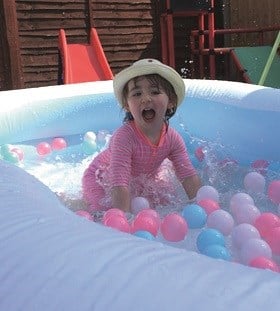A splash of technology
Summer 2022
Nowadays, most modern hearing aids and cochlear implants can handle a little everyday moisture, such as sweat and rain, but they may require additional protection to make them completely safe to use in water.
When you’re going swimming or visiting the beach this summer, you might remove your child’s hearing technology to prevent it from getting wet. However, this can cause communication difficulties, as your child won’t be able to hear you clearly.
Swimming and water activities are a great way for children to keep cool in the summer and are great fun too! But it’s important to be aware that most hearing devices are not waterproof without some extra protection.
Hearing aids
While most hearing aids are water-resistant to a certain extent, they’re not waterproof. Today, hearing aid manufacturers are confident that their devices will tolerate light water activities such as splashing while playing in a paddling pool, running through sprinklers and walking in light rain. However, your child must not wear their hearing aids in the shower or submerge them underwater in a pool or bath.
At present, there are no waterproof covers or accessories designed for hearing aids, as sealing the output speaker would block the amplified audio, so it wouldn’t help anyone to hear.
In 2011, Siemens released the world’s first waterproof hearing aid, Aquaris. This was designed to let sound in and keep the elements out. However, despite its initial success, it was discontinued a few years ago. Last summer, Phonak announced that their new Audéo Life hearing aids are waterproof. These have a high degree of protection against water and can be submerged up to half a metre. They’re currently only available in the US but are due to become available in the UK this year.
Cochlear implants
There are waterproof accessories available for most cochlear implants, which will allow your child to continue wearing them when swimming or playing in water.
Advanced Bionics manufactured the first waterproof cochlear implant, called Neptune. Users of other Advanced Bionics cochlear implants can use an AquaCase and AquaMic to protect their device from water. This reusable kit makes the cochlear implant fully protected against water.
MED-EL cochlear implant users can make their devices waterproof by using a WaterWear sleeve. This provides an airtight seal to make sure the processor and coil is kept dry in the water. WaterWear sleeves are available for Opus, Sonnet, Rondo and Samba audio processors and they can be reused up to 20 times.
Those who have Cochlear Nucleus cochlear implants can use Aqua sleeves with an Aqua coil to make their audio processors waterproof. There are also Aqua cases available for Kanso users. Depending on individual usage, the Aqua sleeves and cases can be reused up to 50 times.

Isabelle (4), who is profoundly deaf and wears two cochlear implants, uses her Aqua kit when she goes swimming. Her mum Nicky, who is also deaf, said:
“It was fantastic to see her face as she heard the sound of splashing water in the pool for the first time. We’ve stuck to just using one processor in the water at the moment. Our paranoia tells us that if it did get waterlogged and needed replacing, at least she wouldn’t be left without any hearing. While the sound is a little muffled through the cover, after a few minutes’ wear, she adjusts and can still hold a conversation and turn to her name.
It always takes a few extra minutes to get ready for swimming and it can sometimes be tricky with a wiggly and impatient little lady but it’s always worth it. We’re incredibly grateful that the technology enabling Isabelle to hear has gone one step further to give her sound in the water. What a lucky little water baby she is.”
Bone conduction hearing devices
Bone conduction hearing devices, such as the Cochlear Baha range and the Oticon Ponto models, are not currently waterproof and don’t have any accessories to protect them against water. They should be removed before going swimming or participating in water activities.
How water-resistant is my hearing technology?
To check the water-resistance of your child’s hearing technology, refer to the user manual and look for the IP (Ingress Protection) code or rating. The first number refers to protection against solid particles, such as dust and sand. The highest achievable level is 6, meaning that the device has complete protection. The second digit represents the device’s water resistance. Most modern hearing devices achieve number 8, meaning the equipment should survive an immersion of a depth of more than one metre, but this should only be for a short amount of time, such as when accidentally dropped in water.
If a hearing device becomes immersed in water, you must retrieve it as soon as possible. Follow the steps below.
- Gently shake the device to remove excess water and use a soft cloth to dry the exterior.
- Remove any batteries, the earmould and tubing.
- Store the device in a warm (but not hot) place, such as a drying box, or use drying capsules for 24 hours. These can be obtained from your audiologist or bought from online retailers such as Connevans.
- Alternatively, place the device in a container of uncooked rice to draw out any excess moisture; make sure you close the battery door to prevent rice getting inside.
If the hearing device still does not work after 48 hours, contact your audiology department. Do not place the hearing device in a microwave or oven, as this will cause irreversible damage.
See further information and tips about swimming with deaf children.
